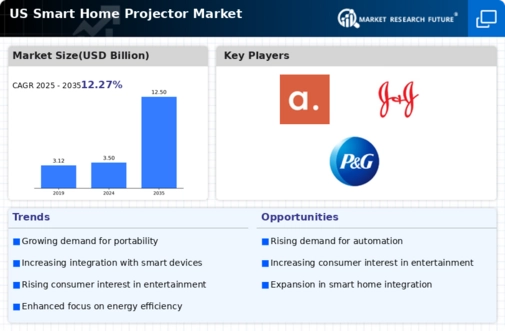The competitive insights of the US Smart Home Projector Market reveal a dynamic landscape characterized by rapid technological advancements and evolving consumer preferences. This market has gained considerable traction as a result of the increasing adoption of smart home devices and the growing trend of home entertainment solutions. Companies are continually innovating to enhance their product offerings, leading to a variety of projectors equipped with advanced features such as wireless connectivity, high-resolution displays, and integration with other smart home technologies.
Competitive strategies within this market focus on collaboration, brand positioning, and leveraging online sales channels to reach a broader consumer base. As the demand for high-quality home entertainment systems escalates, the competitive environment will witness further shifts influenced by pricing strategies, customer experience, and brand loyalty.
Kodak has established a notable presence in the US Smart Home Projector Market, primarily emphasized by its legacy in imaging and innovative technology. The brand is recognized for offering projectors that combine excellent image quality with user-friendly features, appealing to tech-savvy consumers and those seeking convenient entertainment solutions at home. Kodak's strengths lie in its strong brand recognition and expertise in imaging, which allows it to cater effectively to the growing demand for portable and aesthetically pleasing projectors. The company's strategic focus on enhancing product functionality, ease of use, and connectivity ensures it remains competitive in a rapidly evolving market.
By promoting its projectors as not just devices for casual viewing but as integral components of a modern smart home multimedia experience, Kodak positions itself favorably against competitors.
BenQ has carved out a significant niche in the US Smart Home Projector Market through its commitment to quality and innovation. The company boasts an impressive lineup of projectors that cater to a variety of consumer needs, from compact and portable models ideal for small living spaces to more robust systems designed for home theater experiences. BenQ's strengths include a solid reputation for high-quality image performance and advanced technological features such as integrated wireless display options and compatibility with popular smart home platforms.
The company has consistently focused on enhancing user experience through superior product design and performance, allowing it to maintain a competitive edge. Recent mergers and acquisitions have bolstered its market presence, enabling BenQ to expand its product offerings and reach. The brand's continuous investment in research and development positions it to respond effectively to market trends, ensuring relevance in the fast-paced smart home ecosystem in the United States.












